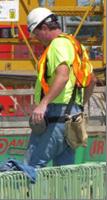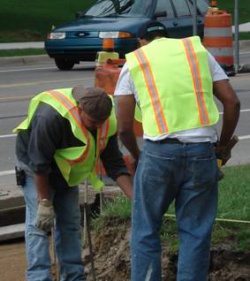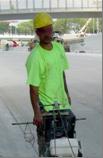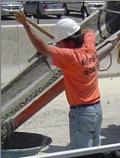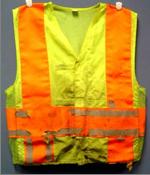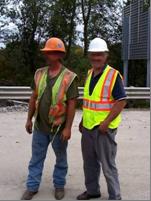104.07 Contractor Obligations
Project & Worksite Safety
The following criteria are to be used when directly witnessing safety issues:
- Immediately suspend all work on the project related to or associated with the safety issue and report to your supervisor and the respective construction/project engineer any worker or worksite safety issue or practice in which any person (contractor, motorist, pedestrian, MDOT, etc.) could get seriously injured or killed. The observation applies to any tier contractor, supplier, motorist, inspection staff, pedestrian, etc. Contact your supervisor or the Safety and Security Administration at 517-241-1697 on any questionable issues. Any verbal directions to suspend work are to be followed up immediately with the issuance of Form 1165, Notice of Non-Compliance with Contract Requirements
- Serious safety issues are defined as, but not limited to, falls, electrocutions, struck-by, crushed-by/caught-between, and excavations.
- Report all safety issues that could result in injury to any person or damage to private or public property to the contractor and document the issue with an Inspector Daily Report (IDR). Immediately inform your supervisor and the respective construction/project engineer.
- The construction/project engineer is to contact the MIOSHA central office at 517-322-1814 or 800-866-4674 as well as the MDOT Safety and Security Administration at 517-241-1697 if a contractor fails to address any safety issue as requested.
- Document all safety issues in an IDR.
- Place pictures of all safety issues in the project files. The use of a camera or portable device is encouraged only when personal safety can be maintained and the safety of others is not compromised.
- Document and consider all safety issues as part of the interim and final contractor performance evaluation process.
The following criteria apply directly to project oversight work:
- MDOT employees or their representative must be provided safe access to inspect all contract work as required in Subsection 104.01.E of the Standard Specifications for Construction. If safe accommodations are not provided you must notify your supervisor and the respective construction engineer for further action and direction.
- Issue Form 1165, Notice of Non-Compliance with Contract Requirements, for safety issues that are not immediately resolved or the presence of any unsatisfactory conditions.
- Immediately contact your supervisor and the MDOT Safety and Security Administration at 517-241-1697 when the Michigan Occupational Safety and Health Administration (MIOSHA) visits a MDOT project office or MDOT worksite. Further information regarding MIOSHA visits can be found on the MDOT Safety and Security Administration internal web page under the safety topic of MIOSHA Visits.
Worker Visibility
In 2006, the Federal Highway Administration (FHWA) issued 23 CFR, Part 634, Worker Visibility Final Rule, which required that, “All workers within the right-of-way of a Federal-aid highway who are exposed either to traffic or to construction equipment within the work area shall wear high-visibility safety apparel." This rule had a compliance date of November 24, 2008. The rule has been incorporated into the 2009 Federal Edition of the Manual on Uniform Traffic Control Devices (MUTCD) and thus also into the 2011 Michigan MUTCD and expanded the worker visibility application to all public roads effective December 31, 2011.
The MMUTCD, Section 6D.03, standard states that:
- All workers, including emergency responders, within the right-of-way who are exposed either to traffic (vehicles using the highway for purposes of travel) or to work vehicles and construction equipment within the TTC zone shall wear high-visibility safety apparel that meets the Performance Class 2 or 3 requirements of the ANSI/ISEA 107–2004 publication entitled “American National Standard for High-Visibility Safety Apparel and Headwear” (see Section 1A.11), or equivalent revisions, and labeled as meeting the ANSI 107-2004 standard performance for Class 2 or 3 risk exposure, except as provided in paragraph 5. A person designated by the employer to be responsible for worker safety shall make the selection of the appropriate class of garment.
A contractor that is not in compliance with the worker visibility requirements as put forth in the MMUTCD is to be issued a Notice of Non-Compliance with Contract Requirements (Form 1165). Furthermore, as this is a primary safety issue, use a contractor performance evaluation (both interim and final) to document issues with compliance to this federal and MDOT requirement.
Subsection 104.07.B of the Standard Specifications for Construction states, in part, the following:
- The Contractor must comply with all local, state, and federal laws and regulations governing construction methods and the furnishing and use of safeguards, safety devices, protective equipment, and environmental and hazardous materials controls.
High-visibility apparel is to be marked or labeled with the specific standard and performance class it meets.
The vests shown below do not meet the standard. These examples are the old style high visibility vests that do not meet the ANSI 107 standard. Notice the narrow width of the retro-reflective strip and the lack of material around the torso. Vests that only cover the front and back of the wearer do not meet the standard.
Bright colored t-shirts (see below) may have background material that meets one requirement of the ANSI standard; however, in order for the shirt to meet the entire standard it must have retro-reflective material/strips. Some contract workers claim they do not need the retro-reflective strips on their clothing, as they are not working at night. However, the FHWA final rule does not allow for anything other than an ANSI 107 Class 2 or 3 compliant garment, which must have retro-reflective strips. It should be noted when workers are performing welding, cutting, or brazing operations, the use of a high visibility vest may create an additional hazard unless the vest is flame retardant.
Excessively dirty or worn vests, examples shown below, do not afford an appropriate level of visibility for the workers and must either be washed or replaced. The American Traffic Safety Services Association brochure is a valuable guidance document showing acceptable and unacceptable examples of high-visibility apparel and provides guidelines for replacement. Please refer to the brochure, http://www.workzonesafety.org/fhwa_wz_grant/atssa/atssa_high_visibility in conjunction with this safety topic.
The Worker Visibility Final Rule applies to all workers within the right-of-way of a federal aid highway. In addition to our contractors and annual permit holders, this requirement applies to consultants, municipal, and county agencies, as well as contract counties performing any type of work on federal aid roads.
Further information can be found on the Safety and Security website under the Safety Topic, Worker Visibility Final Rule.
Workplace Conduct Expectation
It is MDOT policy to promote a safe environment for its employees, free from acts of violence, threats of violence, or harassment. Any verbal or physical conduct or communication that substantially interferes with an employee’s ability to get work done, or creates a hostile, threatening, offensive, and/or intimidating work environment shall not be tolerated. Complaints of violence, threats of violence, or discriminatory harassment shall be investigated. Violators of this policy shall be subject to disciplinary action or contract sanctions.
In accordance with the Standard Specifications for Construction, it shall be the contractor's responsibility to protect the life and health of all personnel on the job. The contractor shall perform the work in whatever manner may be required to comply with all applicable laws. Acts or threats of violence towards State employees, State customers, citizens, or other persons having business association with MDOT will not be tolerated. Violation of these requirements may result in a suspension of work by the engineer in accordance with subsections 104.01 and 107.01 of the Standard Specifications for Construction. In addition, violation of these requirements will be considered unacceptable performance by the contractor and may result in actions up to and including a loss of pre-qualification.
Equipment Back-Up Warning
Material handling equipment, which is any equipment that moves material in any manner, shall have a back-up warning system in place. This is for the safety of all and is a requirement per MIOSHA’s Construction Safety Standard, Part 13, Mobile Equipment, which states:
No employer shall use any motor vehicle equipment having an obstructed view to the rear unless:
(i) The vehicle has a reverse signal alarm audible above the surrounding noise level or:
(ii) The vehicle is backed up only when an observer signals that it is safe to do so.
This rule applies to all employers, including prime contractors, subcontractors, and trucking companies delivering and removing material from the jobsite.
Costs incurred to comply with this requirement will be the responsibility of the employer/contractor.
Should a contractor not comply with this requirement, a Notice of Non-Compliance with Contract Requirements (Form 1165) should be issued. Furthermore, as this is a primary safety issue, use a contractor performance evaluation (both interim and final) to document issues with compliance to this MIOSHA requirement.
See Also
102.02.2 - Preconstruction Meeting
